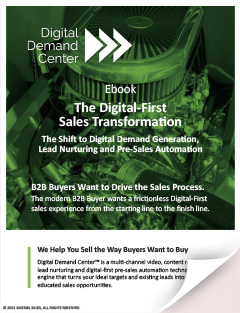
Marketers say that the biggest benefits of automation are saving time (74%), increased customer engagement (68%), more timely communications (58%) and increased opportunities including up-selling (58%) (Adestra).
While marketing automation has been a legitimate business solution for more than five years now, it’s not until recently that’s it’s gathered more interest from small- and medium-sized B2B businesses. And why not, it’s a proven tool for your sales process – producing an average of 14.5% increase in sales productivity and reducing overall sales and marketing overhead by an average of 12.2%.
And these gains are realized even when most SMBs fail to leverage the true power of marketing automation to take care of the early stage sales funnel/buyer’s journey customer education. Because unfortunately, most SMBs only use marketing automation tools to send newsletters. In fact, more than 60% of marketers limit the use of their platform for email blasts to stay in touch with existing customers, and only 13% are using automation software in more advance ways (Autopilot).
Marketing automation platforms produce the best return on investment when they are used to run lead development campaigns, to score leads and to capture information about your potential customers to make your sales staff more productive. Marketing automation can make your sales and marketing operations more effective and efficient by attracting leads, educating them about your products and solutions, identifying and measuring their interest, and providing their level of real interest in your product or services. Sales may then cherry-pick the leads that express the most interest and are most likely to buy.
Here are five ways marketing automation can help you grow your sales at a lower cost.
Marketing Automation enables you to nurture not-yet-ready-to-buy prospects.
It takes an average of between 7 and 13 touches to develop a buyer before a sale is made. Marketing automation can become a stand-in for a junior level sales and marketing person, sharing company information and knowledge directly with your potential buyers. For those leads that are already aware of your solution, but aren’t yet ready to buy, marketing automation allows you to stay top-of-mind and build trust with your leads by offering educational content about industry trends and developments. It allows you to further boost your online presence, highlight product enhancements, and establish industry-leading influence. And it works: nurtured leads produce an average of a 20% increase in sales opportunities versus non-nurtured leads (DemandGen Report).
Research has shown that only 5% of B2B prospects are ready to buy at any given time. And 50% of qualified leads are not ready to buy either (Gleanster Research). And yet, many B2B companies today do not have a strategy to develop these opportunities; so sales reps simply discard them as ‘not interested.’ However, by nurturing your leads with light, educational content on a regular basis, you can stay top-of-mind and over time, develop real active interest (and deals) from leads you generated 6 to 12, to even 18 months ago.
Marketing automation allows you track and manage your early stage prospects and their content engagement on an ongoing basis as they go through the buyer’s journey over and extended period of time. The tool then reports data back to your team about their overall interactions, rather than by each individual campaign. This data is pushed to your CRM and used to more accurately identify and communicate to sales what leads need attention.
Lead nurturing works: 67% of B2B marketers say they see at least a 10% increase in sales opportunities through lead nurturing. And 15% companies report seeing an increase of 30% or more (Demand Gen Report). The top companies that excel at lead nurturing, generate 50% more sales ready leads at a 33% lower cost (Forrester Research).
Marketing Automation allows you to track content engagement by prospect.
96% of visitors who come to your website aren’t ready to buy (yet) (Marketo). And only 25% of those leads are legitimate and should advance to sales (Gleanster Research).
One of the greatest features of marketing automation is the ability to measure each piece of content a prospect has consumed throughout their interaction with your emails and website. These measurements help you monitor and analyze the buyers journey, allowing you to better understand customer buying behavior, identify your most engaging content, and pinpoint the preferred and most active distribution channels.
Marketing automation allows you to score prospects according to the type of content they’ve engaged with. Different types of content are scored based on how predictive they are in relationship to a buyer stage in your sales cycle. Basic educational content is not as highly scored as video webcasts about a specific buyer pain/need or demo videos relating to a specific solution. Each email sent within an automation campaign is scored to identify what content is interesting to buyers and how frequently they are engaging with it.
This type of data allows you to see when specific prospects have shown enough interest, so it makes sense for a sales rep to reach out with a personal email or phone call to move the deal forward. By using this type of dynamic lead scoring, you will have the ability to rank and score formerly unquantifiable implicit digital activities and take the appropriate sales action. The use of explicit data – higher scores for different lead criteria – allows you to grade your prospect compared to your ideal customer profile, making your sales team more armed and effective when they make first contact. These sales automation efforts seamlessly pass top scoring prospects over to well-prepared sales reps with background information on the leads interest in real-time.
Overall, lead scoring allows your sales team to focus on the most interested buyers and allows you to prioritize buyers that are the best fit for your company’s solution.
Marketing Automation allows you to use analytics to refine and improve your content and sales process.
One of the most valuable things marketing automation provides is data. Using the platform’s analytical features, you can track and monitor engagement at a more detailed level in order to understand when and how to improve. For example, platforms provide data for when a video is watched. This allows you to identify which pieces of content are being consumed, and which are not. Your marketing team can create more of what works, making pivots to making the right marketing investments easier to understand and execute.
Real-time lead alerts via email allow your sales team to follow-up faster when buyers are actively engaged in your content and submit a request. And we all know, time is money: there’s a 10x drop-off in lead qualification when sales waits longer than five minutes to respond to a lead – and a 400% decrease when sales waits 10 minutes or more (HBR, Insidesales).
With these alerts and summaries sales reps can more easily:
- Prioritize their day with the most active prospects
- Call buyers when they know they are sitting at their desk
- Click on links to trigger CRM profile lookups for buyer insights
- Send custom emails to active prospects with a few quick clicks
Additionally, marketing automation provides buyer intelligence for your marketing team. It shows what topics/pains buyers are most motivated by. And many of these reports are available in your CRM. Information like original lead source, specific page views, how long they spent on the page, webinar attendance and video views can also be tracked and analyzed. This type of data allows sales and marketing to work effectively together to drive sales as a team.
Marketing Automation Improves Lead Generation
Demand Gen’s State of Demand Generation study shows, 77% of buyers want different, targeted content at each stage of their research. Marketing automation allows you to send certain messages at designated times to your database Nurturing campaigns communicate with buyers through every step of the buyer’s journey – staying in front leads not yet ready to buy. This lowers cost dramatically and reduces lead churn rate, and helps you get the most from your lead generation efforts because it enables your company to stay in touch with buyers over a long period of time without the expense and time of regular check in phone calls by sales reps. With lead nurturing, sales reps don’t waste time chasing leads not yet ready to buy, while the marketing team prevents cold leads from slipping through the cracks.
Marketers using automation software generate 2x the number of leads than those using blast email software and are perceived by their peers to be 2x as effective at communicating with buyers (Autopilot, 2015; Hubspot Marketing Statistics). Enough said.
About Us
Gabriel Sales specializes in helping SMBs and Startups grow their business with modern sales and marketing operations.
Our team can augment gaps in your existing sales and marketing operations or we can be leveraged for full-service campaigns that include:
- Integrated Sales and Marketing Strategies
- Database Research and Targeting
- Automation and CRM Systems Best Practices Implementation
- Inbound Lead Generation
- Outbound Lead Generation and Lead Scoring
- Sales Qualification
- Closing
To learn more about how we can help you grow your business (or decide if we are the right fit for you), we invite you to visit our page that details our integrated approach to sales and marketing outsourcing. Or feel free to contact us for free initial consultation and discovery session to see if our approach is the right fit to help you hit your revenue targets.




